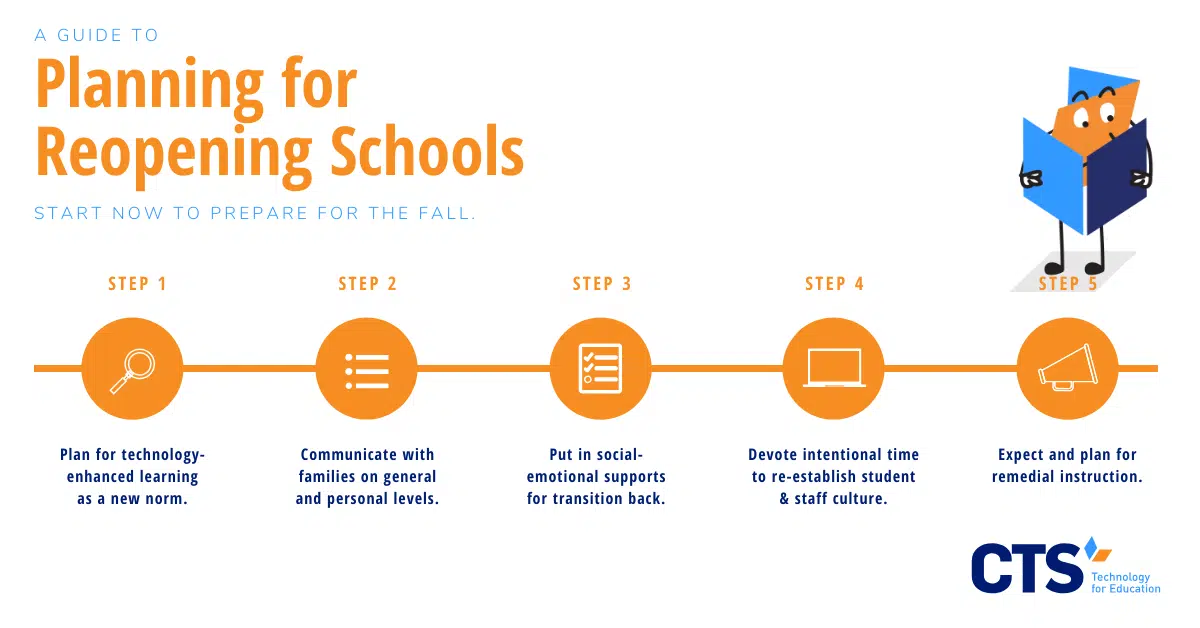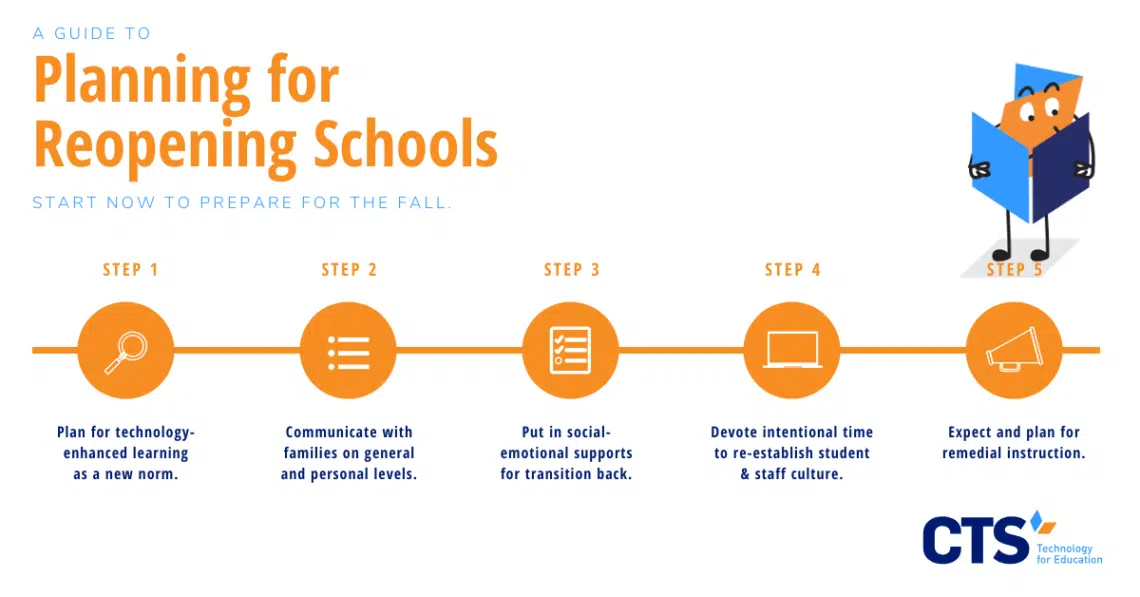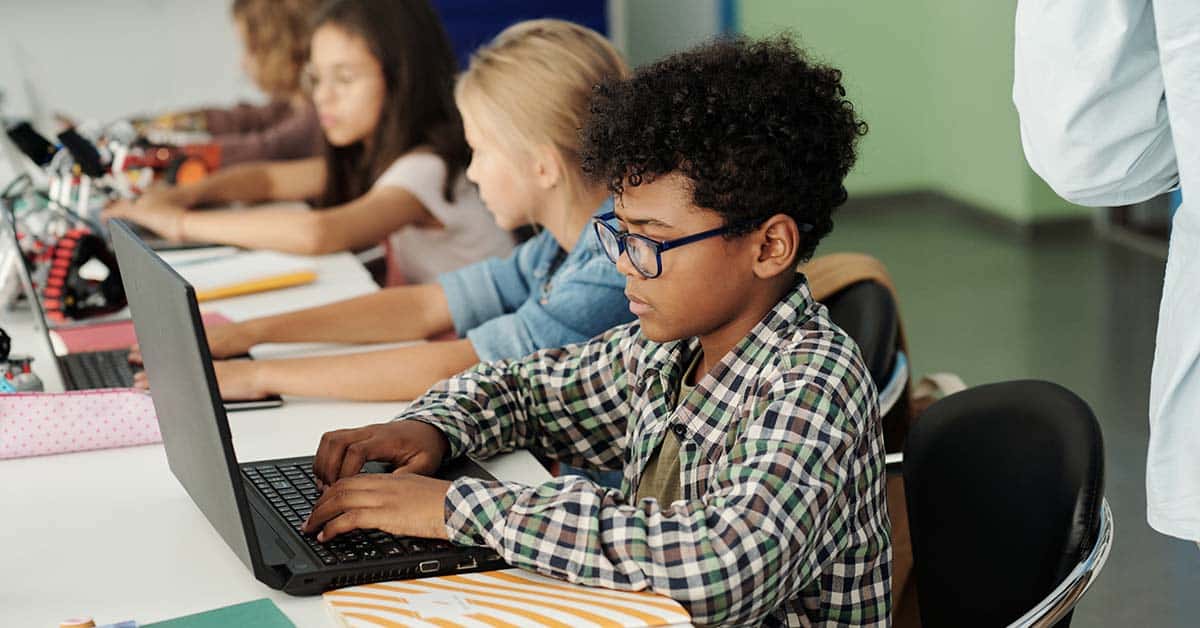Ensure your school community has a clear understanding of the precautions you’re taking to keep everyone safe.
For many students, families, and staff members, a return to in-person instruction is fraught with risk. As a result, school leaders should prioritize both the implementation and communication of measures designed to keep the school community safe. Clearly outlining, for example, the contours of a staggered schedule, daily arrival and dismissal procedures, or whether traditional school gatherings like sporting events will occur can provide school communities with at least some of the confidence necessary to transition from remote learning.
Continue to integrate technology into both short- and long-term planning.
Administrators should also continue integrating technology into both short- and long-term planning efforts. Once teachers and students return, many lesson plans, teaching methodologies, and even communication styles will continue to mirror those geared toward remote instruction. Rather than dramatically shifting back to traditional instruction, teachers can instead opt for a gradual transition in which, for example, the first half of the class is devoted to online learning, coupled with teacher support, while the second half features more traditional instructional methods.
In the longer-term, with the possibility of a second wave of infections in mind, school leaders can begin planning for scenarios in which exclusively remote learning begins at some point during the year. Using lessons from the spring of 2020, administrators can further refine their distance learning plans to address any specific challenges.
Review and begin to fill any technological gaps identified during remote learning.
Similarly, now is the time to address any gaps in school software, hardware, or other technologies. Working closely with their school’s E-rate service provider, leaders can make the most of their federal funds to prepare teachers and families for the “new normal” of schooling.
Schools that have put off investing in a one-to-one Chromebook ratio may decide, for example, that now is the time to purchase additional devices. Student information systems, online data and assessment platforms, and subscriptions to educational software may also prove to be wise investments. Regardless of whether remote learning begins in the future, investing in new educational software can pay long-term dividends, providing students with accessible ways to engage instructional content no matter where learning occurs.
Provide families with resources to prepare their children for the transition back to school.
Families will require significant support from school leaders as they begin preparing their students to transition back to in-person schooling. Especially for younger students, the sudden shift from distance learning to traditional instruction could prove especially jarring. From staggered schedules to socially distant lunches and limits on whole school activities, students are likely to encounter a schooling experience vastly different from the one they left behind.
Leaders can proactively mitigate these challenges by providing families with clear guidance on how to prepare students for the “new normal” of schooling. Narrating the rhythm of the day, describing how lunch or recess might look or feel, and answering students’ questions in advance of the first day can ease some of the anxiety students may experience.
Plan to introduce social-emotional supports to assist students in transitioning back to school.
Even with family support, a significant number of students may experience social-emotional challenges upon returning to school. Navigating socially distant relationships with peers, re-adjusting to the demands of a prolonged, uninterrupted school day, and re-acclimating to routines like homework, to name a few, could leave students feeling drained and frustrated. Even students who normally don’t require SEL supports may find themselves in need of individual counseling.
Leaders can begin preparing for these needs by proactively empowering their counseling, social worker, or SEL teams to assume a greater role in daily school programming. Creating space during each class period for students to reflect on their new schooling experience, as well as giving counselors the flexibility to pull students from class as needed, can help to center—and for students, validate—the anxieties that may come with a return to school.
Pay careful attention to student behavior and communicate any concerns to families.
Throughout this process, it’s important that counselors, teachers, and other school support staff remain especially vigilant to note any abnormal student behaviors. Communication with families throughout this time period is key, especially for those who have children with special needs.
While many students will likely navigate the transition back to in-person instruction with ease, others may feel anxiety due to either fear of COVID-19 or adjustment to a radically different routine. In either case, families and teachers can partner with one another to emphasize the normality of these emotions and provide students with a safe space to work through their concerns and re-establish a positive relationship with the school.
Intentionally devote time to re-establishing the school’s student and staff culture.
As with the start of any new school year, but especially in the case of a post-COVID-19 fall, schools should also devote substantial time to the community-building activities central to a healthy, functioning student and staff culture. Largely confined to their homes for the past several months, both adults and children can benefit from re-acclimation to routines heavily dependent on interaction with other people.
Re-emphasizing the bonds between students and their peers, as well as between teachers, can ease the transition from remote to in-person instruction and create space for members of the school community to support one another in uncertain times. Here, too, SEL teams can play a leadership role in cultivating your school’s student and staff culture.
Expect, and plan for, remedial instruction.
While many schools have successfully designed and implemented distance learning programs, others lack the resources—like Chromebooks—to do so effectively. As a result, many students will likely require remedial instruction as the school year begins. Adjusting curricular choices now will save administrators time once the school year begins and also allow school teams to creatively think through solutions to any deficits in content knowledge. Administering baseline assessments at the beginning of the year or increasing the frequency of small group instruction may feature prominently in school schedules post-pandemic.
CTS is uniquely positioned to help communities transition back to school.
Working with more than 60 school partners across the country, our team is uniquely aware of the challenges likely to accompany a shift back to in-person instruction. Whether it’s supporting schools with data collection and management that may have fallen by the wayside or further refining a learning management system, our team can help your school effectively integrate technology into its daily programming.
In addition to reviewing our COVID-19 resource guide, contact us today to learn more about our managed IT and E-rate provider services, both of which can help your school navigate the months ahead as you prepare to re-open.





